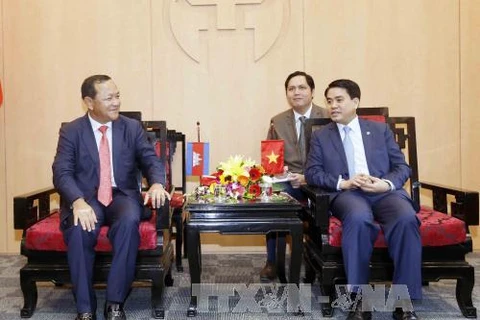Hanoi (VNA) – Hoang Trung Hai, Secretary of the Hanoi Party Committee, talks to Viet Nam News Agency about the city’s achievements in 2017 and plans for 2018.
Can you share with us some of your thoughts on Hanoi’s socio-economic achievements in 2017?
I have to say that I have mixed feelings about the achievements, challenges and limitations of the city’s policymakers in the year 2017.
Throughout the year, all members of the Hanoi Party Committee have pulled their efforts to bring the 16th Congress of the municipal Party Committee to life. As a result, in 2017, all 20 targets laid down by the City Party Committee were fulfilled, and seven targets were surpassed.
When you became Hanoi’s Commander in Chief, which issues captured your attention most?
I should say all fields have their own challenges. But Hanoi is the capital city, and has its own characteristics requiring us to have a deep understanding so that we can develop good and workable solutions. This is a key factor for us to win the hearts and minds of the Hanoi people.
That’s why all Hanoi leaders have devoted much of their time to go to the grass-roots level to meet the people and talk to them. For example, I myself went to all 30 precincts/districts and many communes/wards in the city to talk with local leaders and people in order to learn what was happening over there. Through those visits, I realised that quite a few policies or programmes of the city have not been properly prepared or met the people’s expectations. This is something we have to consider carefully and improve.
Does the city have any plans to overcome such limitations or weaknesses?
I should say in 2017 the entire city political system did their best to raise the city’s image in the eyes of all Vietnamese people and foreigners.
Worthy of note, in 2017 the city settled more than 80 complicated cases relating to national security and policy as well as law and order. Coupled with that, all economic and social targets laid down by the city have been accomplished.
What did Hanoi do to help poor outlying districts and communes improve their people’s livelihoods following the expansion of the city’s administrative border?
The city has concentrated its resources and human power to narrow the gap between urban and rural areas. The municipal People’s Committee has invested a lot of money to improve rural infrastructure and created many specialised agricultural zones to raise the people’s income and to develop more products for consumers. As a result, many new types of co-operatives have been established and their service is of high quality.
Hanoi’s campaign to build new-style rural areas has been progressing quickly. By now it has become a role model for other cities and provinces.
Have you heard the sentence “In Hanoi, every thing must take time to settle”?
I understand that people want their problems to be solved quickly. But those in power think there is no need to rush.
To solve this problem, the city has come up with many solutions, particularly the campaign to reform the working style of the city’s white clerk officers. We have developed a road map to turn the city into a smart city to provide better public services to the people. For example, taxation offices, customs offices and department of natural resources and the environment have all improved their public service and have received many positive comments from their clients.
By now the city has re-arranged the organisations/services in 22 departments/offices in 30 precincts, districts and townships. As a result, we have cut down the total number of administrative units from 401 to 280 (a reduction of 30.2 percent). All in all, some 1,267 jobs have been cut. I should say following the staff re-arrangement, work quality remains the same with high quality and efficiency.
In 2017, Hanoi’s PCI (Provincial Competitiveness Index) increased by 10 steps, ranking 14/63 provinces/cities – the highest ranking so far. Meanwhile the city’s Public Administrative Reform (PAR Index) was third – an increase of six steps and the readiness for information and communications technologies (ICT) ranks second in the country.
Hanoi also ranks first in the number of dossiers transacted online and the only locality in the country to provide the public service at the third level in the field of judiciary in all 100 communes, wards and townships – the lowest administrative units in Vietnam.
What measures has Hanoi adopted to solve the problem of traffic congestion and pavement encroachment?
To solve these problems, the city has developed a roadmap to limit private vehicles operating in the inner city. The city will deploy more public transport, including opening more buses or BRT to create transportation links between the inner city and outlying districts. We’ll adopt good and effective management while creating a level playing field between traditional taxi fleets and Uber or Grab.
Hanoi will build more ring roads and connected roads to avoid traffic congestion in the inner city and to connect easily with satellite towns/cities or provinces. In the pipeline, the city has built and will build more light by passes to help avoid traffic congestion inside the city centre. - VNA
VNA

























